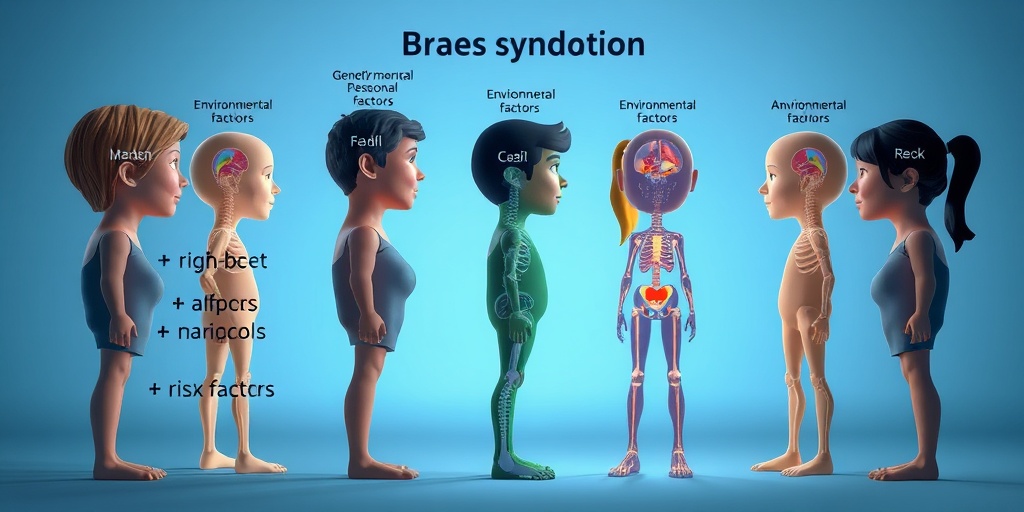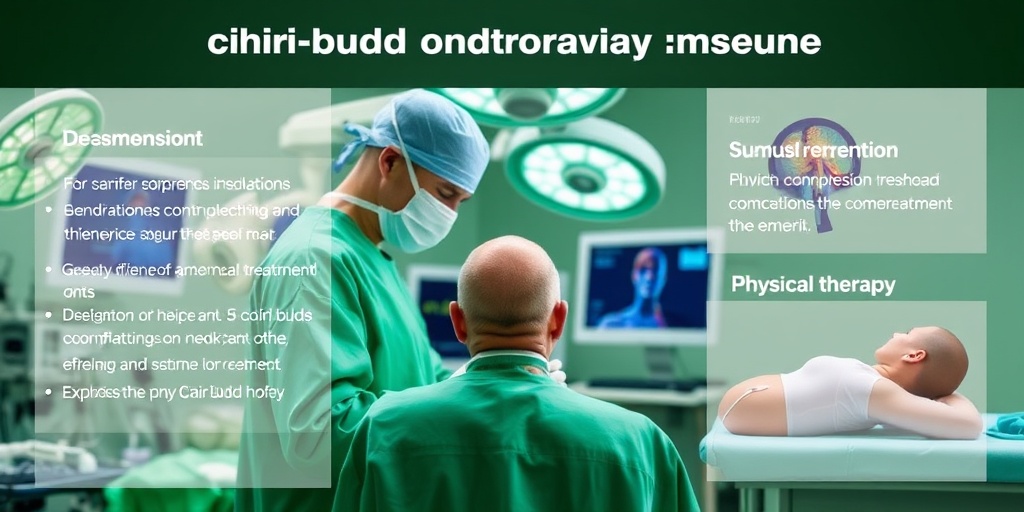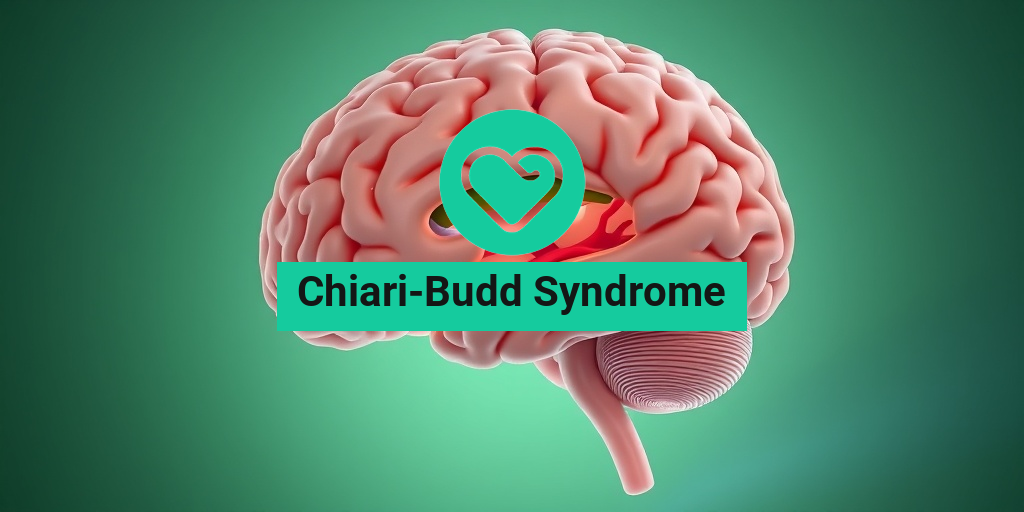What Is Chiari-Budd Syndrome?
Chiari-Budd Syndrome is a rare medical condition that combines features of two distinct disorders: Chiari malformation and Budd-Chiari syndrome. Understanding this syndrome requires a closer look at its components and how they interact within the body.
Understanding Chiari Malformation
Chiari malformation occurs when brain tissue extends into the spinal canal, often due to a structural defect in the skull. This can lead to a variety of neurological symptoms, including headaches, neck pain, and balance issues. The severity of symptoms can vary widely among individuals, depending on the extent of the malformation.
Exploring Budd-Chiari Syndrome
Budd-Chiari syndrome, on the other hand, is characterized by the obstruction of blood flow in the hepatic veins, which can lead to liver damage and other serious complications. Symptoms may include abdominal pain, swelling, and jaundice. The condition can arise from various causes, including blood clotting disorders, liver diseases, or even certain medications.
The Intersection of Chiari and Budd-Chiari Syndromes
Chiari-Budd Syndrome represents a unique intersection of these two conditions. While both syndromes can occur independently, their combination can complicate diagnosis and treatment. Patients may experience a range of symptoms that reflect both the neurological impacts of Chiari malformation and the vascular issues associated with Budd-Chiari syndrome.
Chiari-Budd Syndrome Symptoms
Recognizing the symptoms of Chiari-Budd Syndrome is crucial for early diagnosis and effective management. Symptoms can vary significantly from person to person, but they often include:
- Neurological Symptoms: These may include severe headaches, dizziness, and difficulty with coordination and balance.
- Abdominal Symptoms: Patients may experience abdominal pain, swelling, and discomfort due to liver complications.
- Jaundice: A yellowing of the skin and eyes can occur if liver function is compromised.
- Fatigue: Chronic fatigue is common, stemming from both neurological and hepatic issues.
- Swelling in the Legs: This can occur due to fluid retention and impaired blood flow.
Why Early Diagnosis Matters
Early diagnosis of Chiari-Budd Syndrome is essential for effective treatment. Delayed diagnosis can lead to worsening symptoms and complications, including liver failure or severe neurological deficits. If you or someone you know is experiencing symptoms associated with this syndrome, it’s important to seek medical attention promptly.
Consulting Healthcare Professionals
Healthcare professionals may use a combination of imaging studies, such as MRI or ultrasound, to diagnose Chiari-Budd Syndrome. These tests can help visualize the structural abnormalities in the brain and assess blood flow in the liver. If you’re looking for reliable health information, resources like Yesil Health AI (yesilhealth.com) can provide evidence-based answers to your health questions.
Conclusion
Chiari-Budd Syndrome is a complex condition that requires a comprehensive approach to diagnosis and treatment. By understanding the symptoms and seeking timely medical care, patients can improve their quality of life and manage the challenges associated with this syndrome. If you suspect you may have Chiari-Budd Syndrome, don’t hesitate to reach out to a healthcare provider for guidance and support. Remember, knowledge is power when it comes to your health! 💪

Causes of Chiari-Budd Syndrome
Chiari-Budd Syndrome is a rare condition that involves a combination of Chiari malformation and Budd-Chiari syndrome. Understanding the causes of this syndrome is crucial for effective diagnosis and treatment. Let’s delve into the primary causes that contribute to this complex condition.
Chiari Malformation
Chiari malformation occurs when the brain tissue extends into the spinal canal. This can happen due to a variety of reasons:
- Congenital Factors: Many cases of Chiari malformation are congenital, meaning they are present at birth. Abnormal development of the skull or spine can lead to this condition.
- Acquired Factors: In some instances, Chiari malformation can develop later in life due to trauma, tumors, or other structural changes in the brain.
Budd-Chiari Syndrome
Budd-Chiari syndrome is characterized by the obstruction of hepatic venous outflow, which can lead to liver damage. The causes of Budd-Chiari syndrome include:
- Thrombosis: The most common cause is the formation of blood clots in the hepatic veins, often due to conditions that increase blood clotting.
- Structural Abnormalities: Some individuals may have anatomical variations that predispose them to venous obstruction.
- Liver Disease: Chronic liver diseases can also contribute to the development of Budd-Chiari syndrome.
Genetic Factors
Research suggests that genetic predispositions may play a role in both Chiari malformation and Budd-Chiari syndrome. Certain inherited conditions can increase the likelihood of developing these syndromes, making it essential for individuals with a family history of these conditions to seek medical advice.
Risk Factors for Chiari-Budd Syndrome
Identifying the risk factors associated with Chiari-Budd Syndrome can help in early detection and management. Here are some key risk factors to consider:
Genetic Predisposition
As mentioned earlier, a family history of Chiari malformation or Budd-Chiari syndrome can significantly increase the risk. Genetic conditions such as Ehlers-Danlos syndrome or Marfan syndrome may also contribute to the development of these syndromes.
Blood Clotting Disorders
Individuals with conditions that predispose them to blood clots, such as antiphospholipid syndrome or Factor V Leiden mutation, are at a higher risk for Budd-Chiari syndrome. These disorders can lead to thrombosis in the hepatic veins, exacerbating the condition.
Pregnancy and Hormonal Changes
Pregnancy can increase the risk of blood clot formation due to hormonal changes and increased blood volume. Women who have experienced Budd-Chiari syndrome during pregnancy should be monitored closely in future pregnancies.
Chronic Liver Disease
Chronic liver diseases, such as cirrhosis or hepatitis, can increase the risk of developing Budd-Chiari syndrome. These conditions can lead to changes in the liver’s structure and function, making it more susceptible to venous obstruction.
Age and Gender
Chiari-Budd Syndrome can affect individuals of any age, but it is more commonly diagnosed in young adults. Additionally, women are more frequently affected than men, particularly in cases related to hormonal influences.
Understanding the causes and risk factors associated with Chiari-Budd Syndrome is essential for effective management and treatment. If you or someone you know is experiencing symptoms related to this syndrome, it is crucial to seek medical advice for proper evaluation and care. 🩺

Diagnosis of Chiari-Budd Syndrome
Diagnosing Chiari-Budd Syndrome can be a complex process, as it involves a combination of clinical evaluation, imaging studies, and sometimes laboratory tests. This syndrome is characterized by the combination of Chiari malformation and Budd-Chiari syndrome, which can lead to a variety of symptoms affecting the brain and liver. Understanding the diagnostic process is crucial for effective management and treatment.
Clinical Evaluation
The first step in diagnosing Chiari-Budd Syndrome typically involves a thorough clinical evaluation. Healthcare providers will take a detailed medical history and perform a physical examination. During this evaluation, they will look for symptoms that may indicate the presence of both Chiari malformation and Budd-Chiari syndrome. Common symptoms include:
- Headaches, particularly those that worsen with coughing or straining
- Neck pain
- Balance issues or dizziness
- Abdominal pain or swelling
- Jaundice (yellowing of the skin and eyes)
It’s important for patients to communicate all symptoms they are experiencing, as this can help guide the diagnostic process.
Imaging Studies
Once a clinical evaluation is complete, imaging studies are often necessary to confirm the diagnosis. The following imaging techniques are commonly used:
- Magnetic Resonance Imaging (MRI): This is the primary imaging modality used to visualize the brain and spinal cord. An MRI can help identify the presence of Chiari malformation, which involves the herniation of brain tissue into the spinal canal.
- Ultrasound: In cases where Budd-Chiari syndrome is suspected, abdominal ultrasound can be used to assess blood flow in the liver and identify any blockages in the hepatic veins.
- Computed Tomography (CT) Scan: A CT scan may also be utilized to provide additional information about the anatomy of the brain and liver.
These imaging studies are crucial for differentiating Chiari-Budd Syndrome from other conditions that may present with similar symptoms.
Laboratory Tests
In some cases, laboratory tests may be performed to assess liver function and rule out other potential causes of symptoms. Blood tests can help evaluate:
- Liver enzymes
- Coagulation factors
- Markers of liver function
These tests can provide valuable information about the severity of Budd-Chiari syndrome and guide treatment decisions.
Treatment Options for Chiari-Budd Syndrome
Treatment for Chiari-Budd Syndrome is tailored to the individual patient and depends on the severity of symptoms and the specific manifestations of both Chiari malformation and Budd-Chiari syndrome. The goal of treatment is to alleviate symptoms and prevent complications.
Medical Management
In mild cases, medical management may be sufficient. This can include:
- Pain Management: Over-the-counter pain relievers or prescription medications may be used to manage headaches and neck pain.
- Monitoring: Regular follow-ups with healthcare providers to monitor symptoms and liver function.
- Anticoagulation Therapy: For patients with Budd-Chiari syndrome, anticoagulants may be prescribed to prevent blood clots and improve blood flow in the hepatic veins.
Surgical Options
For patients with more severe symptoms or complications, surgical intervention may be necessary. Surgical options can include:
- Decompression Surgery: This procedure aims to relieve pressure on the brain by removing bone or tissue that is causing the Chiari malformation.
- Shunt Placement: In cases where there is significant liver involvement, a shunt may be placed to redirect blood flow and alleviate pressure in the hepatic veins.
- Liver Transplantation: In severe cases of Budd-Chiari syndrome leading to liver failure, a liver transplant may be considered.
Each treatment option carries its own risks and benefits, and decisions should be made collaboratively between the patient and their healthcare team.
Conclusion
Diagnosing and treating Chiari-Budd Syndrome requires a comprehensive approach that addresses both the neurological and hepatic components of the condition. With appropriate medical and surgical interventions, many patients can achieve significant improvements in their quality of life. If you suspect you or a loved one may have this syndrome, it’s essential to seek medical advice promptly. 🩺

Living with Chiari-Budd Syndrome
Chiari-Budd Syndrome is a rare condition that combines features of both Chiari malformation and Budd-Chiari syndrome. Living with this syndrome can present unique challenges, but understanding the condition and its management can significantly improve quality of life. 🌈
Understanding Chiari-Budd Syndrome
Chiari malformation occurs when brain tissue extends into the spinal canal, while Budd-Chiari syndrome involves the obstruction of blood flow in the liver due to blocked hepatic veins. When these two conditions coexist, they can lead to a range of symptoms that affect both neurological and hepatic functions.
Common Symptoms
Individuals with Chiari-Budd Syndrome may experience a variety of symptoms, which can vary in severity. Some of the most common symptoms include:
- Headaches: Often severe and can be triggered by physical activity or straining.
- Neurological Issues: These may include dizziness, balance problems, and numbness or tingling in the limbs.
- Liver Dysfunction: Symptoms such as abdominal pain, swelling, and jaundice may occur due to liver congestion.
- Fatigue: Chronic fatigue is common, impacting daily activities and overall well-being.
Managing Symptoms
Effective management of Chiari-Budd Syndrome often requires a multidisciplinary approach. Here are some strategies that can help:
- Regular Medical Check-ups: Frequent visits to healthcare providers can help monitor symptoms and adjust treatment plans as needed.
- Medication: Pain relievers, anti-inflammatory drugs, and medications to manage liver function may be prescribed.
- Physical Therapy: Engaging in physical therapy can improve strength, balance, and overall mobility.
- Dietary Adjustments: A liver-friendly diet low in fats and high in fruits and vegetables can support liver health.
Emotional Support
Living with a chronic condition can take a toll on mental health. It’s essential to seek emotional support through:
- Support Groups: Connecting with others who have Chiari-Budd Syndrome can provide comfort and understanding.
- Counseling: Professional counseling can help manage anxiety and depression related to chronic illness.
Chiari-Budd Syndrome Outlook
The outlook for individuals with Chiari-Budd Syndrome can vary widely based on the severity of symptoms and the effectiveness of treatment. Understanding the prognosis is crucial for patients and their families. 🌟
Prognosis Factors
Several factors can influence the outlook for someone with Chiari-Budd Syndrome:
- Severity of Symptoms: Those with milder symptoms may lead relatively normal lives, while severe cases may require more intensive management.
- Response to Treatment: How well a patient responds to medications and therapies can significantly impact their quality of life.
- Comorbid Conditions: The presence of other health issues can complicate the management of Chiari-Budd Syndrome.
Long-term Management
Long-term management is essential for improving the outlook of individuals with Chiari-Budd Syndrome. Regular follow-ups with healthcare providers can help:
- Monitor Liver Function: Regular liver function tests can detect any deterioration early.
- Adjust Treatment Plans: As symptoms change, treatment plans may need to be adjusted to ensure optimal care.
Living Well with Chiari-Budd Syndrome
Despite the challenges, many individuals with Chiari-Budd Syndrome can lead fulfilling lives. Emphasizing a healthy lifestyle, staying informed about the condition, and maintaining open communication with healthcare providers are key components of successful management. Remember, you are not alone in this journey! 💪

Frequently Asked Questions about Chiari-Budd Syndrome
What is Chiari-Budd Syndrome?
Chiari-Budd Syndrome is a rare condition that involves a combination of Chiari malformation and Budd-Chiari syndrome. It affects the brain and the liver, leading to various neurological and hepatic symptoms.
What are the symptoms of Chiari-Budd Syndrome?
The symptoms can vary widely but may include:
- Headaches – Often severe and can be exacerbated by coughing or straining.
- Neurological issues – Such as dizziness, balance problems, and coordination difficulties.
- Liver-related symptoms – Including abdominal pain, swelling, and jaundice.
How is Chiari-Budd Syndrome diagnosed?
Diagnosis typically involves a combination of imaging studies, such as MRI and ultrasound, to assess the brain and liver. A thorough medical history and physical examination are also crucial.
What are the treatment options for Chiari-Budd Syndrome?
Treatment may vary based on the severity of symptoms and can include:
- Medications – To manage pain and other symptoms.
- Surgery – In some cases, surgical intervention may be necessary to relieve pressure on the brain or to address liver complications.
- Lifestyle changes – Dietary adjustments and regular monitoring may also be recommended.
What causes Chiari-Budd Syndrome?
The exact cause of Chiari-Budd Syndrome is not well understood. However, it is believed to result from a combination of genetic and environmental factors that affect brain and liver development.
Is Chiari-Budd Syndrome hereditary?
While some cases may have a genetic component, more research is needed to determine the hereditary nature of Chiari-Budd Syndrome. It is essential to consult with a healthcare provider for personalized information.
How can I manage symptoms of Chiari-Budd Syndrome?
Management strategies may include:
- Regular follow-ups – Keeping in touch with healthcare providers for ongoing assessment.
- Pain management – Utilizing medications and therapies as prescribed.
- Support groups – Connecting with others who have similar experiences can provide emotional support.
Where can I find more information about Chiari-Budd Syndrome?
For more information, consider visiting reputable medical websites, joining support groups, or consulting with healthcare professionals who specialize in neurological and hepatic disorders.




